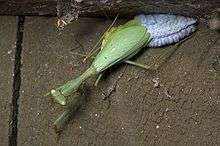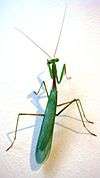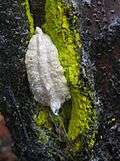Miomantis caffra
| Miomantis caffra | |
|---|---|
 | |
| Laying her egg case | |
| Scientific classification | |
| Kingdom: | Animalia |
| Phylum: | Arthropoda |
| Class: | Insecta |
| Order: | Mantodea |
| Family: | Mantidae |
| Genus: | Miomantis |
| Species: | M. caffra |
| Binomial name | |
| Miomantis caffra Saussure, 1871 | |
Miomantis caffra is a species of praying mantis native to Southern Africa. It was discovered to have spread to New Zealand in 1978.
Description
Ootheca
The ootheca (egg case) of M. caffra is 12–30 mm long with rounded sides, soft creamy-brown, fawn or beige with a terminal handle-like extension. Hatching is not synchronised, and nymphs may emerge over a period of weeks or even over two seasons.
Nymphs
The nymphs are green or brown, body often longitudinally striped, limbs mottled, tip of abdomen curved upwards.
Adults

Adults of M. caffra are usually 32–60 mm long, pale green or brown, occasionally with pink or purplish colouration near base of fore-wing; hind wings green or bright yellow. Pronotum narrower than head, approximately 1/3 of body length, rounded dorsally and swollen over the leg attachment. There are two dark pigment spots on the inner surface of the fore-femur. Males are smaller, more slender and have longer antennae than females. The abdomen of a pregnant female extends well beyond the wings.
Behavior
In its natural environment, M. caffra tends to hide under leaves. A very active and aggressive species, the males of M. caffra are usually eaten immediately after copulation.
New Zealand

In New Zealand M. caffra is commonly referred to as the springbok mantis or the South African praying mantis. The first specimens to be found in New Zealand were nymphs collected by an Auckland schoolboy at his home in New Lynn, Auckland during February 1978. These were reared to adulthood and a colony based on them was established and maintained by the Entomology Division, DSIR. Initially their identity caused problems as the specimens were unlike any other Australian or Pacific species examined. Finally Dr A. Kaltenbach of the Naturhistorisches Museum, Vienna, identified the specimens as a common Southern African species, Miomantis caffra. Although not considered a pest species, it is thought to be displacing the New Zealand native species (Orthodera novaezealandiae) in urban environments of northern New Zealand.
References
| Wikimedia Commons has media related to Miomantis caffra. |
- New Zealand Entomologist, 1984, Vol 8. Miomantis caffra, a new mantid record (Mantodea: Mantidae) for New Zealand. G. W. RAMSAY
- NZ Landcare Research